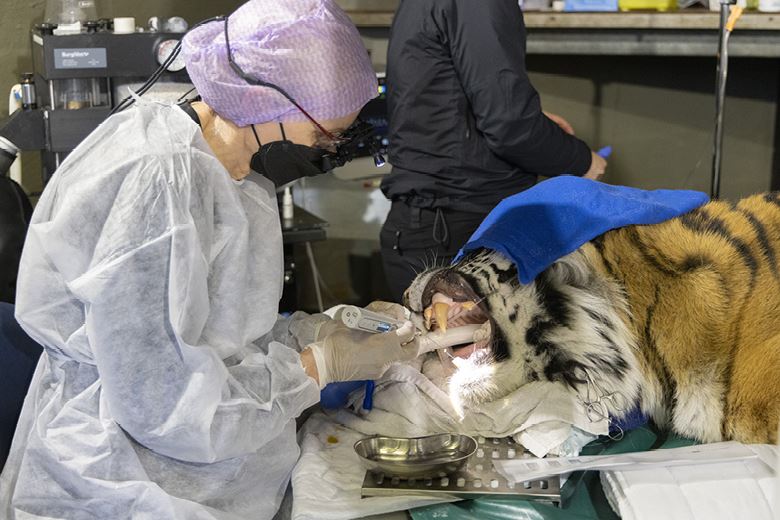Root canal for a tiger? Korkeasaari Zoo carries out a rare procedure
Korkeasaari Zoo had a rare opportunity to carry out a root canal treatment on a predator when an X-ray revealed that Sibiri, a 10-year-old female tiger, had developed an inflammation requiring intervention. Sanna Sainmaa, a veterinarian at the Korkeasaari Zoo, initiated a complex treatment planning process that culminated in a collaborative effort in the tiger’s den, bringing together some of Finland’s top professionals in veterinary dentistry.
Article Sep 22, 2025
Root canal treatment became a pressing issue for Siberian tiger Sibiri in October 2023, when animal keepers at Korkeasaari Zoo noticed that her canine tooth had broken. An X-ray of the tooth showed a pulpal inflammation in the damaged tooth.
”It is typical for tigers and many other wild animals to hide signs of illness to avoid appearing vulnerable. Sibiri showed no symptoms, and no changes in her behaviour had been observed despite the condition of her tooth,” explains zoo veterinarian Sanna Sainmaa. Because extracting the 10-centimeter tooth with its long roots would have been difficult, a root canal treatment was considered the best option for the tiger.
Building the operating space in Korkeasaari
The root canal treatment was preceded by lengthy preparations. Dental procedures on Korkeasaari animals are usually performed at the Veterinary Teaching Hospital of the University of Helsinki. However, when it comes to dangerous animals, treatment procedures are performed in their own dens for security reasons.
Since the tiger’s den was converted into an operating space, numerous details had to be considered during the planning process. Staff specialized in the procedure and the necessary equipment had to scheduled. In addition, factors such as temperature, lighting, the number of wall sockets, and the adequacy of space were among the aspects that needed to be taken into account.
Planmeca also got the opportunity to be a part of this rare operation by providing essential equipment. Devices such as the Planmeca Compact™ i dental unit with an independent instrument cart, and the Planmeca ProX™ intraoral X-ray unit, complemented by Planmeca Romexis® software were lent to Korkeasaari for the procedure. Additionally, hand instruments, smaller accessories, and materials were ordered from Plandent to support the treatment.
Procedure requiring special instruments
The root canal operation took about two hours and was performed by Docent Dr Eva Sarkiala, a veterinarian specialized in veterinary oral and dental diseases. ”Root canal treatment on a tiger’s canine tooth is performed in much the same way as it would be on, say, a dog or a human: the root canal is cleaned, disinfected and dried, after which a filling is inserted and a restoration is placed on the fractured surface of the tooth,” explains Dr Sarkiala.
However, it is the 10-centimeter length of the tooth that makes root canal treatment on a tiger particularly challenging – the procedure requires special instruments and caution to ensure that the root canal is properly cleaned and filled.
On the morning of the operation, an animal keeper separated Sibiri from her cubs, and Dr Sainmaa administered anaesthesia to the tiger. Since the tiger weighs approximately 180 kg, it took as many as eight people to lift her onto the operating table. During the procedure, the anaesthesia team from the university managed the maintenance of anaesthesia, while staff from Plandent assisted with the use of equipment involved in the operation.
Improving awareness of the significance of oral health to overall animal health
Dental procedures on dangerous predators have been performed in the United States for quite some time, but in Europe, and in Finland in particular, such procedures have been relatively uncommon. However, awareness of oral health and its importance to an animal’s overall well-being has increased, and there is a growing effort to invest more in this area. ”Nowadays, dental problems are addressed more readily even though animals do not always show clear signs of them,” reflects Dr Sarkiala.
However, Dr Sainmaa stresses that diet is the most important form of dental care for tigers. In connection with the dental procedure, Sibiri was found to have no tartar buildup as she has been fed a diet rich in whole carcasses. This is important not only for the development of her skull but also for naturally cleaning her teeth.
Sibiri’s recovery has gone well
Sibiri’s dental operation was as successful as expected. After the procedure, the tiger was repositioned onto soft cushions within her den, where her recovery began smoothly. Both Dr Sarkiala and Dr Sainmaa are pleased that the procedure was a success. They especially wish to thank the skilled and dedicated staff participating in the procedure, as well as the reliable and capable partners at Korkeasaari Zoo, the Veterinary Teaching Hospital and Plandent. Despite the exciting and unique nature of the procedure, all parties performed their roles flawlessly and in accordance with the plan. “Teamwork was excellent,” sums up Dr Sarkiala.
According to a follow-up update received from Korkeasaari Zoo in June 2025, Sibiri is doing well. The animal keepers regularly check upon her tooth – no external changes have been observed since the operation, and the tooth appears healthy.
Copy: Iiris Yli-Jama and Katja Kurki
Images: Annika Sorjonen and Kaisu Ilomäki






